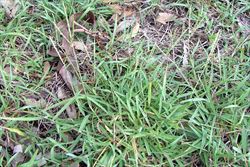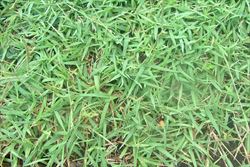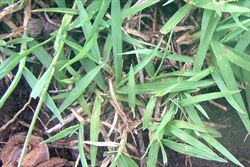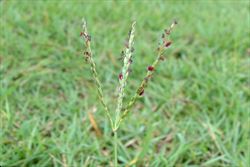Click on images to enlarge

infestation (Photo: Sheldon Navie)

habit (Photo: Sheldon Navie)

habit growing as a lawn (Photo: Sheldon Navie)

bluish-green leaves (Photo: Sheldon Navie)

close-up of creeping stems and leaves (Photo: Sheldon Navie)

typical seed-head with two main branches and tiny third branch (Photo: Sheldon Navie)

seed-head with three branches (Photo: Sheldon Navie)

close-up of immature flower spikelets (Photo: Sheldon Navie)
Scientific Name
Digitaria didactyla Willd.
Family
Gramineae (South Australia)Poaceae (Queensland, New South Wales, the ACT, Victoria, Tasmania, Western Australia and the Northern Territory)
Common Names
blue couch, blue couch grass, blue serangoon grass, crabgrass, green serangoon grass, Qld blue couch, Queensland blue couch, Queensland bluecouch
Origin
This species is thought to have originated in the Mascarenes (i.e. in Mauritius and La Reunion). However, some authorities regard it as being native to some parts of eastern Australia (i.e. eastern Queensland and eastern New South Wales).
Naturalised Distribution
Naturalised near Perth in south-western Western Australia and regarded as being widely naturalised in south-eastern, central and northern Queensland. It is also present in many parts of eastern New South Wales, but some authorities regard it as being native to this area.
Notes
Blue couch (Digitaria didactyla ) is regarded as an environmental weed in some parts of Queensland and New South Wales (i.e. in the wider Sydney and Blue Mountains region and on the New South Wales North Coast). It is very widely grown as a lawn grass and is a common weed of inhabited areas.
However, it is thought to have also spread into natural habitats including tropical and sub-tropical wet sclerophyll forests, brigalow forests, wetlands, riparian areas and tropical and sub-tropical open woodlands. Blue couch (Digitaria didactyla) is probably of most concern in south-eastern Queensland, where it is currently regarded as among the top 100 most invasive plant species.

